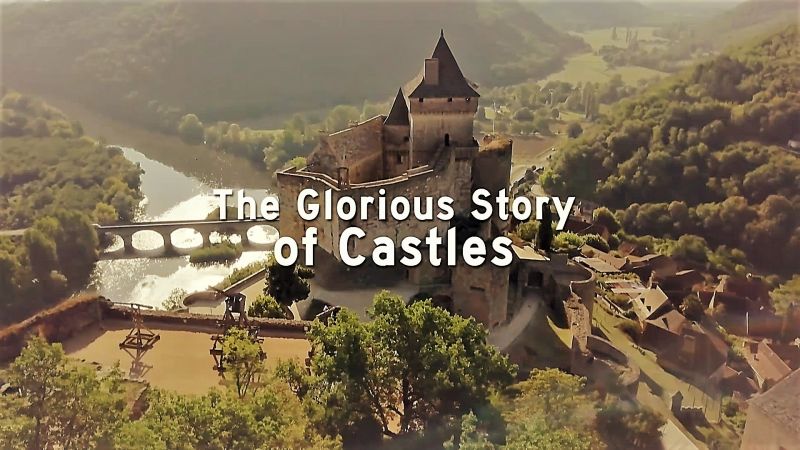The Glorious Story of Castles: carriers of myths and legends, castles strongly mark our imaginations, appearing most often as the pivot of a dark and barbaric period. Reality is different. They are full of mystery and grandeur, emblematic abstractions of the Middle Ages, they testify to medieval civilization.
The Glorious Story of Castles
A castle is a type of fortified structure built during the Middle Ages predominantly by the nobility or royalty and by military orders. Scholars debate the scope of the word castle, but usually consider it to be the private fortified residence of a lord or noble. This is distinct from a palace, which is not fortified; from a fortress, which was not always a residence for royalty or nobility; and from a fortified settlement, which was a public defence – though there are many similarities among these types of construction. Usage of the term has varied over time and has been applied to structures as diverse as hill forts and country houses. Over the approximately 900 years that castles were built, they took on a great many forms with many different features, although some, such as curtain walls, arrowslits, and portcullises, were commonplace.
European-style castles originated in the 9th and 10th centuries, after the fall of the Carolingian Empire resulted in its territory being divided among individual lords and princes. These nobles built castles to control the area immediately surrounding them and the castles were both offensive and defensive structures; they provided a base from which raids could be launched as well as offered protection from enemies. Although their military origins are often emphasised in castle studies, the structures also served as centres of administration and symbols of power. Urban castles were used to control the local populace and important travel routes, and rural castles were often situated near features that were integral to life in the community, such as mills, fertile land, or a water source.
The Story of Castles in Europe: A Journey Through Time
The Dawn of Castle Construction
In the heart of Europe, the story of castles begins in the Middle Ages, a period marked by warfare and the need for fortification. Castles, with their towering walls and imposing keeps, were more than just homes for the nobility; they were symbols of power and protection. The first castles were built from wood, but as technology advanced, stone became the material of choice, offering greater durability and resistance against attacks.
The design of these fortresses evolved over time, with the motte-and-bailey castles giving way to the more complex concentric castles. These architectural marvels, with their multiple layers of defense, were not only formidable but also a testament to the ingenuity of their creators.
The Golden Age of Castles
The 12th and 13th centuries marked the golden age of castle construction in Europe. During this time, castles became more than just military strongholds; they transformed into lavish residences for the nobility, complete with luxurious interiors and sprawling gardens. The castles of this era, such as the Château de Chambord in France and the Alhambra in Spain, are renowned for their architectural grandeur and intricate designs.
This period also saw the rise of the castle town, where communities developed around these fortresses, providing services and goods to the castle inhabitants. These towns played a crucial role in the economic and social development of medieval Europe.
The Decline and Transformation of Castles
As the Middle Ages waned, so did the need for castles. The advent of gunpowder and cannons rendered the thick walls of castles ineffective. Many were abandoned, left to crumble into ruins. However, some found new life in the hands of the wealthy, who transformed these once formidable fortresses into opulent palaces and manor houses.
The 16th and 17th centuries saw the rise of the Renaissance castle, characterized by their ornate architectural style and emphasis on comfort over defense. These castles, such as the Château de Versailles in France, are a testament to the changing times and the evolving needs of their inhabitants.
The Legacy of European Castles
Today, the castles of Europe stand as a testament to the continent’s rich history. They are cherished as cultural heritage sites, attracting millions of tourists each year. These architectural marvels offer a glimpse into the past, telling stories of kings and queens, battles and sieges, and the rise and fall of empires.
The legacy of these castles extends beyond their physical presence. They have inspired countless works of literature and art, from the fairy tales of the Brothers Grimm to the epic fantasies of J.R.R. Tolkien. They continue to captivate our imagination, reminding us of a time when knights and nobles walked their halls.
The Enduring Fascination with Castles
The story of castles in Europe is one of evolution and transformation. From their origins as simple wooden fortifications to their current status as iconic landmarks, castles have shaped and been shaped by the history of Europe. Their enduring fascination lies in their ability to transport us back in time, offering a tangible connection to the past.
As we explore these ancient fortresses, we are not just observing old stones and mortar. We are stepping into a story that spans centuries, a story that continues to unfold with each passing day. The story of castles in Europe is our story, a story that continues to captivate and inspire.




